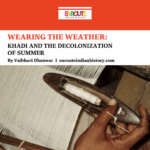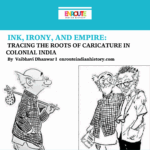Article written by EIH Researcher and writer
Rayana Rose Sabu
Mumbai, or lovingly बम्बई, a city built by the dreams, aspirations, and labour of its citizens, has mesmerised everyone with its allure and vibrant lifestyle. Mumbai welcomes anyone with wide arms, regardless of status, race, or caste.
Home to labourers, starlets, criminals, exotic birds, artists, fisherfolk, and millionaires, the city’s stunning old-world architecture coexists with modern high rises. This coastal metropolis is home to Asia’s largest slums, one of the most prolific film industries, and the most significant urban tropical forest. Mumbai is the financial hub, the centre of the fashion industry, and the religious epicentre of India.
Like any other metropolis, Mumbai has a rich past that has formed the city into what it is today.
Scratch the surface of modern Bombay, and the name Sassoon will appear. The Sassoon family, who arrived in colonial Bombay in 1830 as Jewish refugees from Baghdad, provided the city with infrastructure, schools, and places of worship. They had a vast supply of land at their disposal, on which they erected many mills that fueled Mumbai’s economy till the mid-twentieth century. This site is now ground zero for cloud-piercing buildings, vast shopping complexes, and malls.
David Sassoon was the son of Sepeheikh Sassoon, who held a banker’s office to a local ruler. When the governor of Baghdad was ousted, the Sassoon family sought another location to live. In 1828 David Sassoon went to Basra and continued towards Bushire, Iran, where his ageing father joined him along with his family. After the sheikh passed away in 1830, David and his family moved to India, ripe with opportunities for entrepreneurs. They arrived in India just as the British East India company had relaxed its monopoly on trade, and they joined other Iraqi Jewish families. The Ezras, The Ezekeiels and the Gubbays in the cotton and opium trade that was burgeoning in the East, especially China.
Fluent in Arabic, Hebrew, Turkish, and Persian, David and his family forged a unique hybrid identity joining the ranks of the Indian mercantile elite while still coveting British citizenship. They preserved their traditions, such as their cuisine, and were intensely religious like other Baghdadi Jews.
David began by building his empire specifically through the opium trade with China; he dispatched his sons to various Chinese ports, and soon enough, they held a firm grip on the movement of the prized
Malwa opium from Mumbai to China. For their business to expand, they depended on British politics, the Ottoman Empire, Iran, and India as the drug’s suppliers and China and Southeast Asia as their major markets. The Sassoons took great pleasure in their company, and Davis’s son Abdallah had a family crest made that included a bursting poppy.
They quickly began expanding into trading textiles but soon got into trouble with the Parsi community, who owned the turf. As a result, they could not moor at the jetties near Ballard Pier. Thus, he decided to design and construct his port, utilised mainly by trawlers and fishermen. The eldest son of David Sassoon, Albert Abdullah David Sassoon, also known as Albert, owned it when it was constructed in 1875. Sassoon Docks was Western India’s first for-profit wet port, contributing to Sassoon’s consolidation of control over the cotton trade. The Princes Dock in Bombay Presidency was built using the port’s design as a model since even the British thought it was beautiful. The textile industry was prosperous, and the Parsees, Gujaratis, and Sassoon fought for a piece of the action. Sassoon had the advantage, though, with his new port and the nearby railway lines that extended into the port complex.
David Sassoon quickly understood that his fortunes depended on producing fabrics in Bombay rather than importing them from Lancashire, making him highly important to the city. By the 1860s, he had built up to 17 textile factories in Bombay, employing somewhere between 15,000 and 20,000 people.
But, even with all the wealth and booming business, David could not prevent their empire from being split into two by his sons Albert and Elias; the latter founded a company named E.D Sassoon and Co.Ltd in 1867 and began trading in dry fruits, nankeen, milk, spices, tea and camphor from modest offices in Bombay and Shanghai. Elias outperformed his brother Albert’s David Sassoon & Co regarding entrepreneurialism. Elias quickly outgrew his brother’s business, David Sassoon & Co (£ 0.5 million), with a notional capital of £1.25 to 1.5 million. This was probably the first significant crack in the mighty Sassoon edifice.
By the fourth generation, the business now had fallen into the hands of the younger generation, who were embarrassed by their heritage and industry. Using Jewish networks in Baghdad, the Sassoon family created their international company by hiring locals and spreading their culture. Their uniqueness set them apart, but Anglicization and estrangement further ruined the Sassoon name. Victor Sassoon, a fourth-generation company leader, was taken in by communist rumours that the Indian National Congress would bring about the end of India. So he moved to the commercial centre of China in 1931, lived a life of debauchery, and passed his time with attractive ladies while creepily offering to take their pictures. He returned to India in 1937 after the Japanese attacked Shanghai. The war accelerated the cycle of poor choices, and E.D. Sassoon started selling its mills and assets at steep discounts and swiftly and he moved eventually to the Bahamas.
The Sassoon family company thus came to an end. The Sassoon family may still be well-known today if they had established more substantial roots, but they are now lost in the mists of this great city’s past.
SOURCES
- The Rise and Fall of the Sassoons. (2022, October 6). The India Forum. https://www.theindiaforum.in/history/rise-and-fall-sassoons
- David Sassoon – the biggest wealth generator in Bombay. (n.d.). Moneycontrol. Retrieved February 21, 2023, from https://www.moneycontrol.com/news/business/david-sassoon-the-biggest-wealth-generator-in-bombay-4523271.html
- Sassoon, David | Encyclopedia.com. (n.d.). Www.encyclopedia.com. https://www.encyclopedia.com/international/encyclopedias-almanacs-transcripts-and-maps/sassoon-david
- Mumbai (Mumbai) travel. (n.d.). Lonely Planet. https://www.lonelyplanet.com/india/mumbai-bombay
















